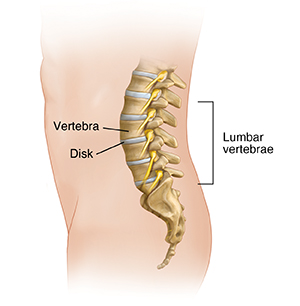Understanding Extreme Lateral Interbody Fusion (XLIF)
A fusion is a surgery to join 2 or more bones together. During an extreme lateral interbody fusion (XLIF), this is done on the lumbar spine. Two of the bones of your back (vertebrae) are joined together, and one of your spinal disks is removed.

Why XLIF is done
You may need XLIF if you have a health condition, such as:
These problems can cause a lot of pain. If pain medicines, physical therapy, or other treatments don’t work, fusion surgery may help relieve the pain.
How XLIF is done
XLIF is done by an orthopedic surgeon or neurosurgeon. The surgery can be done in several ways. XLIF is a minimally invasive surgery. This means it uses a smaller cut (incision) than other kinds of surgery. The surgery does not cut the muscles of your spine. This may help you to recover more quickly. It may also reduce the chance of some complications.
The surgeon will make a small cut through the skin on your side. They will put a special tool called a retractor through the skin. The surgeon will gently push it through the tissues to the spine. It then holds muscle and tissue aside and lets the surgeon see the spine. The surgeon removes the disk. They put a metal or plastic cage, or bone graft into the space between your vertebrae. In some cases, the surgeon may make a second incision on your back. This is done to use screws and rods to anchor your bones in place.
Risks of XLIF
All surgery has risks. The risks of XLIF include:
-
Infection
-
Excess bleeding
-
Nerve or blood vessel damage
-
Blood clots that develop in the legs and may travel to the lungs
-
The bones may not fuse together well
-
Not enough relief of pain
-
New pain at the site of surgery
-
Nerve damage that causes weakness in your leg
-
The need for more surgery
A normal side effect of bone fusion is less flexibility of your spine. In most cases, this limits motion only a small amount and isn’t a major problem.
Your risks vary based on your age and general health. Talk with your healthcare provider about which risks apply most to you.